|
Related FAQs: Turtles, Turtles
2, Sliders, Turtle Identification, Turtle Behavior, Turtle Compatibility, Turtle Selection, Turtle Systems, Turtle Systems 2, Turtle Feeding, Turtle Disease, Turtle Disease 2, Turtle Disease 3, Turtle Reproduction, & by Species:
Musk/Mud Turtles, Other
Sliders/Emydids (Pond, Painted...), Softshells, Snapping Turtles, Mata Matas, Tortoises, & FAQs on Red Ear Sliders:
Sliders, Sliders 2, Red Eared
Slider Identification, RES
Behavior, RES Compatibility,
RES Selection, RES Systems, RES
Feeding, RES Disease, RES Disease/Health 2, RES Reproduction, & Other Reptiles, Amphibians,
Related Articles: Red Eared Slider Care by Darrel
Barton, So your turtle has the Flu? Recognising and
treating respiratory infections in pet turtles by Neale
Monks,
Freshwater
Livestock,
Turtles: ID/Physical Attributes
(i.e., Species ID, Aging, Sexing)
Part 3
To: Part 2,
Part 1
|
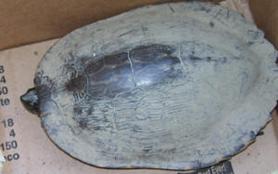
|
| by Sue Garrett |
|
|
NORTH AMERICAN BOX
TURTLES
Terrapene
·
Resemble tortoises but
more closely related to, and in the same family as semi-aquatics
(see above)
· High-domed, rounded
carapace with variable markings and color depending on
species
· Hinged plastron that
clamps their shell shut when frightened
· Toes are only slightly
webbed
· Small to medium size
turtles; grow up to 8 long on average
|
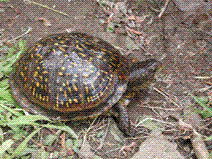
Darrel Barton pic
|
|
Turtle identification
10/10/09
Hello :)
<Hello,>
A friend of my daughter's found this turtle in the woods. I
already scolded him for taking it from its habitat, but now
I'm not sure what to do with it.
<Generally best to release it where found, as soon as
possible. Ideally, contact your local Fish & Wildlife
department to see if a park ranger can take you to an optimal
release site away from things like busy roads.>
I am wondering if I should take it to the pet store even though
my daughter wants to keep it.
<Certainly shouldn't take it to a pet store. For one
thing, wild animals can catch diseases from pet animals, and
_vice versa_. On the other hand, staff at a good reptile and
amphibian store may well know something about the reptiles local
to your bit of the world.>
He is rather small (about as big as the palm of my hand) and the
bottom of his shell is a bit soft.
<Appears to be an Eastern Box Turtle, Terrapene carolina. This
is a highly variable species, but the dome-like shell, brown
colour, and hooked beak are characteristic. The front of the
lower shell is hinged, so when the head is pulled back, a
trapdoor closes off that part of the shell. Males have red eyes,
females brown. I'm assuming you're in the United States
somewhere, where this is species is _by far_ the most common
terrestrial turtle (what here in England we'd call a
tortoise).>
He has a short neck, dark eyes and the bit of yellow colorings
that I can see. seem to be much darker at times and DO appear
much brighter in photos.
<If the eyes are brown, and this is Terrapene carolina, then
"he" is a she.>
He is currently in a large bird cage which we have attempted to
convert for his needs. (Frisbee filled with water, dirt for
burrowing, half of a potters pot for shelter and
"hiding" etc.
<Wild-caught specimens don't especially well in captivity,
though you have covered the key things, particularly water. They
like to bathe, but the water shouldn't be so deep (or the
bowl so steep around the edges) it cannot get out easily. If it
gets through the first few weeks, and eats and drinks normally,
the species can last a long time in captivity. High humidity is
important. Bear this in mind if you decide to keep this animal;
kept properly, it'll outlive you! The record for a wild
specimen is 138 years, and between 50-100 years seems fairly
common. In captivity you can expect upwards of 30 year lifespans,
and up to 60 years has been reported.
Like all reptiles, you need to provide a heat source of some sort
if you do not plan to hibernate the animal. Generally,
hibernating reptiles is tricky unless you have fattened them up
carefully beforehand, and I'd recommend against it, at least
for the first year. The heat source of choice is a lamp, and it
should be one that produces UV-B as well as heat, because they
need UV-B to synthesise Vitamin B1 and convert calcium into bone
and shell.
In short: they need a big vivarium, a bathing pool, a source of
heat, and a source of UV-B. This will be fairly expensive to pull
together, and while there's no rush, you will need to have
all these bits and pieces before it starts getting too cold. In
the wild your Box Turtle would be looking for a resting place to
hibernate, somewhere cool, dry, secure from predators and safe
from flooding. If you want to keep your turtle, you're going
to have to provide a warm, humid alternative.>
He moves very quickly and seems to be quite smart lol. (He found
a way out of the cage within a few minutes of putting him in it
and we were thankful we were there to see it or we never would
have believed it - it's fixed now. - and he already prefers
one shelter corner over the other!).
<Shelter is indeed very important. It's also critical to
make sure predators, particularly pet dogs, can't get into
the cage. Even a "playful" dog could wound or kill a
Box Turtle.>
I have attached some photos and am very curious to know what kind
of turtle he is, how old, gender etc. and most importantly what
he should be eating and what I should do with him.
<As I said, likely Terrapene carolina, probably female if the
eyes are brown rather than red. Age difficult to say; seems to be
full grown, so could be anything from 10 to 100 years!>
we've tried many types of food (lettuce, bugs, cooked eggs,
cooked pork, fruit etc. - so far he seems to prefer the eggs and
pork but only ate each of those once along with a small bit of
cucumber. He seems to eat one day but not the next.
<Avoid "meat", i.e., anything from a warm blooded
animal. The fats in these foods coagulate inside the turtle,
causing problems. Instead opt for mostly greens, romaine lettuce
and curly lettuce being ideal. Augment with soft fruit (melon,
tomato, berries) and offer small amounts of things like
earthworms, mealworms, and white fish. Very occasionally you can
offer them cooked chicken bones, which seem to go down well, but
not too often.>
Thanks in advance for your help.
Brenda
<If you plan to keep this animal, do spend some time reading
up on keeping Eastern Box Turtles in captivity. There are some
excellent reptile books available for pet owners, and one of
those would be a sound investment.
Keeping reptiles in captivity isn't easy, and not something
to do on a whim. It's a shame to capture an animal that can
live for 100 years in the wild, and then kill it after a few
months through neglect. So, make your choice: buy all the stuff
it needs to thrive, or else return the animal from whence it
came, ideally after calling the local wildlife bureau in your
neighbourhood. Hope this helps. Cheers, Neale.>
|
|
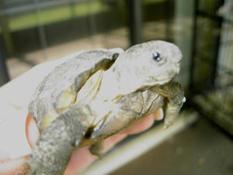
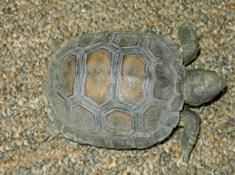
|
|
Re: turtle identification
10/10/09
Thank you so much for a speedy reply.
<My pleasure.>
Based on your information, we have decided it would be most fair
to this little lady if we called our local wildlife bureau and
let her have her chance to live to a ripe old age.
<Good move.>
You have been most helpful.
PS - we Live in Florida, USA. Although we are a very warm and
humid state, we do have our cold days in winter so she would
still need much care.
<Air temperature all year around should be fine if this animal
was kept indoors in a room that wasn't air conditioned. The
main thing is to avoid extremes of heat and coldness; anything
between 15-30 C should be fine, assuming it has access to water
(to keep cool) and a basking lamp (to warm up). But there's
no getting around the fact reptiles are all expensive pets in
terms of setting up their habitat, even though compared to cats
and dogs their long term costs are low (they don't eat much;
kept properly, rarely get sick; and don't need such
procedures as neutering). Still, they're not pets for
everyone. Cheers, Neale.>
|
|
A brand new Baby Box
Turtle 8/25/09
Hi!
<Hiya - Darrel here>
I'm Josie. I found this tiny little thing in my garage,
covered in cobwebs and dead bugs stuck to her! She is SO skinny
and lost one eye! So, of course I had to take her in and settle
her in her new home, because she would've died being out
there all alone, with only one eye, starving, and only being a
baby. I put her in with our 2 year old box turtle that lives in a
(supposed to be) sandbox built-in underneath my children's
play set.
They have a mini pond and a tomato plant out there. I just found
her today.
I know that it's a female because of the cloaca on her tail.
I would just like to know what specie she is, because that would
help me take care of her. I named her Cyclops since she has one
eye.
<What you have there, Josie is a baby box turtle! Cute as a
button and right about that size. I wouldn't go as far as to
say she's female from anything you can see at that age, but
it's as good a guess as male, so
let's go with it.>
<Cyclops appears to be a common box turtle (Terrapene
Carolina). She's omnivorous but will prefer meat initially
and live food, such as earth worms or snails when she can catch
them. She needs fruits and leafy greens like Apples and Collards
as she grows, so keep offering a little bit of that in the diet.
If you offer her small snails, make sure that no one has used any
form if snail bait around -- snails absorb it and it is extremely
toxic to turtles.>
Write back soon. -Josie
<done!>
Re: A brand new Baby Box Turtle
08/26/09
I have been trying to feed her
lettuce, tomatoes, apples and grapes along with Lexi, our older
turtle, but she won't eat them.
<Be careful with lettuce. Collards are good, as are mustard
greens, etc. Romaine is BARELY O.K. and Iceberg is between
useless to actually bad for them>
We always fed Lexi fruits and veggies. I did not know that they
prefer live food.
<As they get older, they tend more toward a vegetable diet,
but it's unusual to find a Terrapene that won't hunt an
earthworm if offered.>
Cyclops is always avoiding Lexi, and our other terrapin,
Fredrica, when I put them together.
<What kind is Fredrica?>
Any advice about that? Thanks for the other info
<Cyclops is frightened, for one thing. For another, turtles
are not social animals. They live in colonies many times (colony
is a geographical area to which they confine themselves and
therefore often cross paths) but
except for mating they mainly ignore or tolerate each other. What
I'm trying to say is that Cyclops is not going to get
companionship or moral support by being with others of her own
kind. In fact, if an adult male
encounters a sub-adult male they've been known to attack
them>
<My suggestion is that you make a sub partition for Cyclops --
just for a while. Let her get used to being out in the world
again. You might try giving her a slightly warm shallow bath for
10 minutes and then offering
her a tiny bit of cat food on the end of a toothpick. That's
how I get my baby box turtles to start eating when they're
"stuck">
Write back soon. -Josie
<Done-- Darrel>
Re: A brand new Baby Box Turtle
8/27/09
Thank you so much for all your
help!
<Yer welcome!!>
You gave me so much good advice!
<YES WE DID! It's why we're here!>
I will do the sub partition.
<Thank you for TAKING the good advice -- you'd be amazed
how many people asked it and then don't>
Thanks.
-Josie
<Darrel>
|
|
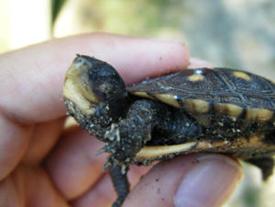
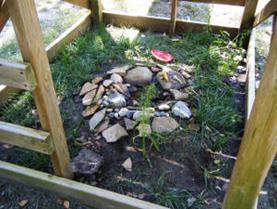
|
|
What kind of turtle is this? 6/5/07
Hi,
<Hi right back!)
My son found a turtle in our front yard. How can I tell what kind
of turtle it is and if it is male/female? I brought it to my vet
( I was on my way there anyway) and they weren't sure what
kind it is.
<Well, there's our first problem. If a veterinarian who
has seen the turtle can't tell you then we here at the Media
aren't going to be able to help you without seeing
it.>
I've been trying to find pictures on line of different kinds
of turtle, but can't find any.
<Well, let's keep at it, OK? Can you send us a picture
taken with a digital camera or cell phone cam? That would give us
a place to start. Here's another: http://www.xupstart.com/wwm
any of those look familiar? Help us to help you and we'll get
there together!>
I found info about care though.
<Let's hold up on that, shall we? If we don't know if
it's a turtle, terrapin or tortoise, we may not have the
right care instructions. For now .... dry & warm, OK?>
Thanks!
Cathy
<you're welcome - Darrel!>
Re: What kind of turtle is this? 6/5/07
Hi,
<Hi Again!>
I sent a note last night and now I'm sending some pictures of
a turtle my son found.
<Note to readers: Cathy sent a link to a private site
containing pictures, so we can't share the pics with you.
Nothing personal.>
Can you tell me what kind of turtle this is?
<Sure -- that is a Box Turtle! Possibly an "Ornate Box
Turtle" Terrapene ornata>
We'd like to keep it as a pet, but want to make sure we are
giving it the proper care.
<Cathy - you've found one of the absolute coolest and most
fun turtles to have! They are intelligent, personable little guys
with distinct and individual personalities and preferences and
they're one of the lowest maintenance pets a person can have.
He'll be very tolerant of any mistakes you might make and
there are very few dangers with Box Turtles.>
I found info on line but need to know what kind it is so that
we
are doing the right thing.
<First, he's a land turtle. He likes water but he
doesn't swim very well or even often, so all he needs is a
shallow pan of clean water where he can drink and lounge.
He's very tolerant of temperatures and can live happily in
almost an temperature that humans like. He can have a hanging
light bulb over a portion of his box or even a heating pad in one
area. He'll eat a wide variety of foods from flower petals to
succulent fruits & berries to earthworms -- and this is the
only thing you really have to watch for: They can very easily get
"hooked" on something like melon or strawberry or such
and refuse all other foods, so make sure you feed him a constant
variety. Don't feed him dog or cat food, crickets or any kind
of mealworms - these are all foods he'll love, that are NOT
good for him but can cause him to refuse other food... and trust
me, he can refuse food a LOT longer than you could stand to see
him not eat.>
Thanks so much!
<I'm glad we got to the bottom of this!>
Cathy
<Darrel>
Re: That's a Box Turtle!
6/5/07
Thanks Crew!
<No problem>
I'm so glad we found out what kind of turtle he or she
is.
<It makes like easier for the turtle, too! One possibility is
that it's an Eastern Box Turtle (Terrapene carolina) in which
case the lack of red or orange eyes would indicate she's a
girl.>
Should I feed him any kind of meat? I got a turtle book and they
mentioned
raw beef or dog food (like a chicken variety). Should I do
this?
<No. When I wrote "no dog or cat food" that would
include all flavors of dog food.>
I knew about the fruits but what about vegetable?
<The key to a happy Box turtle is variation in diet. Melon or
banana today, then perhaps collard or chard on Thursday and then
maybe ONE earthworm (night crawler - available at most pet
stores) on Saturday. Feed her no more than three times a week, in
the morning. Feed her HALF as much as you think she needs and
remove all uneaten food at the end of the day.>
Thanks so much!
<Di nada>
Cathy
|
Old Box
Turtle 5/26/06
My name is Stacy I am 14.
Hi Stacey, Pufferpunk here.>
My sisters boyfriend found this box turtle on the side of the road on a
rainy day. When he got home he gave me the
turtle. I noticed that my turtle has 2 holes in her
shell.
<This is common with older turtles. Had some shell damage
in the past but should be fine & be able to live a long life with
this.>
On his right back leg that he only has 1 nail on it and the other has
all 3.
<Yes, you have a 3-toed box turtle with 1 deformed
foot. No issues there.>
I was wondering what I could do to fix everything that's wrong with
her.
<Nothing to fix. Just things that happen to a turtle in
the wild. Be sure to give it at least a 20 gallon tank, with
a shelter on one side (an overturned box with the side cut out will do
& a water bowl large enough for it to bathe in on the other
side. Be sure to change the water daily, or it will be
drinking poop water. Mulch is a great substrate for
them. It's cheap & you can buy large bags even at
most gas stations during gardening season. Just make sure not to use
cedar, it poisonous! Change every 2 weeks & hand clean
any poop daily (most will be in the water). You will also
need a reflector lamp for warmth.
Food: dark green veggies (no iceberg lettuce--mostly water), any
fruits. Frozen mixed veggies (defrosted 1st, of course) work
well. So do fruit cocktail, well rinsed, for quick
feedings. They love red foods. Canned dog food or
dry soaked in water. Crickets & earthworms (found in
wild-box turtles tummies when dissected), are a favorite
treat. Dust the food with reptile vitamins (be sure they
have calcium in there, for the shell).
If kept properly, a box turtle can live over 30
years! ~PP>
Thanks a lot, Stacy Cline
Box Turtle Lost In Washington State
8/20/05
I'm in Spokane, Wa. and I was driving home when I
found a turtle sitting in
the middle of the road. That's really odd, due to the fact that I,
personally,
am about 5 miles from the nearest water source other than a hose
spigot. I'm
not sure what type or what to do about it.
It's about 6" long, dark brown shell, with yellow markings.
This may sound
really stupid, but I know absolutely nothing about turtles, but the
skin is
rough and has small red "flecks", if you will. His shell, (if
it is a he), is
about 3.5" high. I really don't know what else to tell you,
but I also want to
know how to care for it and so forth. I'm really worried that some
poor kid
is probably worried sick that their pet turtle is missing.
Any advice at all
is welcome. Thanks for your time, Katlin and
"Bogart"
< Sounds like a little box turtle lost his way. Keep him in an
aquarium /terrarium setup of about 40 gallon size (3Ft). They must have
water that they can get in and out of. They need a basking spot on land
with a good heat/sun lamp. They love snails but will eat many fruits
and vegetables. They live for a very, very long time with proper care.
Do a google search on box turtles and you will be busy reading for
hours.-Chuck>
|
BOG
TURTLES
Genus:
Glyptemys
·
Carapace is dark
brown/black, domed and rectangular in shape
· Scutes often have
prominent rings; sometimes a chestnut sunburst pattern can be
seen in each scute
· Plastron has a pattern of
cream and black notches
· Body color is dark with
an orange-red wash on inside of legs of some
individuals
· Head is dark brown and
matches the shell; has a bright yellow, orange, or red spot on
each side of its head/neck
· Smallest species of
turtle in N. America; ave. only 4 as adults
|
|
|
WOOD
TURTLES
Glyptemys
insculpta
· Sculptured-like carapace
with pyramidal scutes; ranges from tan to brown in
coloration
· Plastron is typically
yellow with black blotches on outside edge of each
scute
· Underside of forelegs
often range from yellow to reddish in color
· Neck and tail may be
similar in color to forelegs; head may be speckled with faint
yellow dots
· Can reach carapace length
of 6-9
|
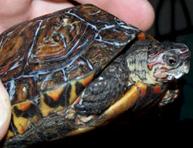
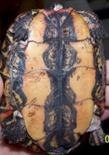
|
ID A Poor Swimming Turtle
07/02/06
Hi, For about a year we've had two
semi-aquatic turtles bought as babies from someone that did not know
what type they were. We first ID'd them as Reeve's Turtles
because they seemed to have 3 keels on their shells, long tails, and
were very poor swimmers. (In fact they can't cope at all with water
deeper than their heads; if they can't reach a pellet, they will
"jump" rather than swim up to it, and generally speaking
their hind legs never leave the bottom. I even tried giving them some
supervised "swimming lessons" in case the shallow water had
just made them lazy, but they're hopeless.) The few pictures we
could find of young Reeve's were not a perfect match for ours, but
didn't seem to rule it out.
We have recently discovered them mating at night, leading us to
conclude that one is male and one female. They have a pretty violent
mating habit in which the male reaches down with his very long neck and
bites the female's neck. He has actually caused her wounds. By
looking up that habit, we came across a S. American species,
Geoffroy's Side-Necked Turtle, the images of which seemed to be a
much closer match for our two. But the description of
Geoffroy's is wrong in two ways: they don't retract their heads
"sideways" in the way the Side-Neck's name implies, and
they are definitely not "excellent swimmers."
They have seemed happy and healthy being treated more or less the same
as our RES but with shallower water, but we're still curious as to
what they are. Any ideas? Thanks! Phil & Diya
<Look at the American Wood turtle (Clemmys insculpta ). This may be
an outdated name, but you should find plenty of info by Googling the
common name. Very cool turtle and may also be rare depending on the
subspecies.-Chuck> <Darrel Besides a Wood or Reeves
Turtle, is it possible that these could have been (imported) Mata Mata
turtles? I mention this partly because of the queriers comment
about their necks and side neck turtles, 3 keels, and the fact theyre
poor swimmers. If so, I may want to move this FAQ under that
species instead as they are quite different turtles than Wood
Turtles.> [Images attached, including one showing them as
babies. Hope the files aren't too big.] <<Nope,
just unfortunately not saved... RMF>>
Rare Wood Turtle Needs Proper TLC -
06/07/2006
Hello Crew,
I just saw Brandon Heuyard's turtle pix &
post of 4-11-2006 post . It is a woodland
turtle,...rare, possibly threatened. It is semi
aquatic, lives near stream & rivers. Needs a lot of good care,
fresh water for soak immersion which must be changed daily suggest
& right
after defecation, food is berries fruit, earth worms, fresh
lean beef cut up small. If one wants to keep one,
I suggest reading up on them, food, habitat & very
important hibernation requirement for continued well being. Not a
child's fun pet , but a serious custody only. I do not
know how to reach & am not figure out how to
access forum. Please post & you may share email address
with him. Ellen < eplanner(AT)ix(DOT)netcom(DOT)com
<<Replace the (AT) with @ and the (DOT)s with . - just trying
to avoid someone getting spammed. -Sabrina>>>
< Thank you for your concern and we will post on the site for all to
read.-Chuck>
|
Suspected semi-aquatic wood turtle of genus
Clemmys 4/11/06
(Original heading: Identification
Issue, turtle - 4/11/2006)
Dear Crew:
<Brandon>
Greetings and Salutations. As a general rule I keep
snakes; however, I managed to acquire a
"turtle." This was more of an animal
surrender as he was not being fed well, possibly was dehydrated,
and just didn't seem to be in optimum health. It
is my goal to remedy that unfortunate situation, Besides, my
daughter immediately fell in love with him. Here is my
question, what type of turtle is it? I have been on
the search for information and just cannot seem to definitively
identify the little guy. For the time being he is in a
20 gallon tank, nice hide spot, new UV lighting, and a dish of
water that he can submerge his entire body while still being able
to get out of it. He is very active, likes to climb,
and has spent some time soaking in his water
bowl. After his soak I had to clean his carapace and
noticed that he does have color. I really think it is
a painted turtle. The person who surrendered it
thought it was a "woodland" turtle from
Canada? I am not sure where she received her
information. He has been a pet for 15 years, and I
believe he has not been kept in a truly 50-50 aquatic
situation. I am sending pictures ( I pray they are not
too large). I am hoping that you can help me identify
this little guy; I want to be able to provide the best possible
environment for him.
<Mmm, looks like a color-variant (due to upbringing) of an
Eastern Painted Turtle to me (Chrysemys picta)... have never
heard of or seen such a thing as a "Canadian Woodland"
turtle>
Again I apologize if I broke the picture rules.
Any help you may be able to offer would be appreciated.
Brandon C. Heuyard
Turtle ID FAQ on 4/10/06
Dear Fearless Leader, I was unable to open the picture sent for
the following question so I sent it back to the freshwater
section. After seeing
it today on the main website it definitely looks like a
semi-aquatic wood turtle in the genus Clemmys. It actually may be
a very endangered Clemmys
muhlenberg. See ya in a couple of weeks.-Chuck
<Yikes... will amend. Danke. BobF>
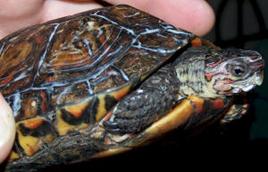
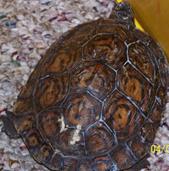
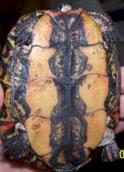
|
South American Wood Turtle
I am
having trouble finding anything on the Suriname wood turtle. Is it the
same as the North American turtle?
<No, totally different species.>
And also what type of habitat, food they need to have for a long
healthy live. thank you for your time
< Your semi-aquatic (Rhinoclemys punctularia) will need an area that
is partial aquarium and partial terrarium. They can be kept like
regular wood turtles except that they need to be kept between 75 and 85
degrees. North American turtles are sometimes cooled down for
hibernation. Do a Google search on the scientific name or South
American Wood Turtle and you will find lots of info on your
turtle.-Chuck>
|
TORTOISES
Testudinidae
·
Many species; vary
considerably in terms of size and color
· Most have high domed
shell with pyramidal scutes
· Columnar, elephant-shaped
legs
· Many species can become
very large in size with shell lengths up to several
feet
|
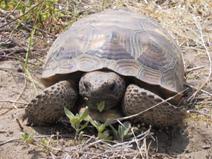
|
|
turtle id 10/24/09
Can you please id this turtle shell. Thanks in advance!
<Hello Pat. While I'd hazard a guess this is some species
of Testudo, or perhaps Geochelone, beyond that I can't offer
any kind of helpful answer without extra data. It's certainly
what here in England we call a "tortoise" -- that
is, a terrestrial rather than freshwater/brackish water
"terrapin" or a marine "sea turtle" (in
British English, the three kinds of chelonian are separated,
rather than lumped under the single word "turtle", even
though etymologically, "turtle" and
"tortoise" mean the same thing).
Identifying chelonians from their shells alone
is a bit of a fine art since there's much variation.
We're primarily fish people here, and while Darrel and I are
probably familiar with the more common freshwater
turtles/terrapins kept as pets, your chelonian shell isn't
one of those species. I'd suggest getting in touch with the
herpetological department of your nearest zoo or natural history
museum and finding out if they can
help. Cheers, Neale.>
|
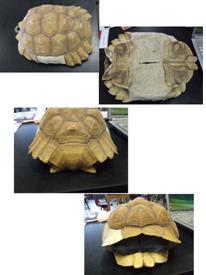
|
|
UNCONFIRMED TURTLE
SPECIES
|
|
Need help w/ turtle i.d.-what to
do?? 5/24/10
Hi - -
<Hello>
I'm hoping you can assist me. I had posted this on another
site but, alas, after 95 hits nobody left me any info. We just
want to do what's best for this little guy.
<Tis good>
About a week ago this turtle showed up in our backyard. Not sure
how he got there since we're all fenced in. He's a little
over a foot long. Last Sunday 'Tommy Turtle' found his
way into our pool. We've fished him out several times and
given him some other water options but he's determined to be
lounging in the pool.
We don't know of anyone in our neighborhood that had a pet
turtle but we do live near a big pond; could he of traveled from
there?
<Sure>
We would like to know what kind he is and if he should be taken
back to the pond.
<Mmm... maybe. There's a chance that this animal is a
"lost pet"... that wandered out of a yard, perhaps
while the owner was cleaning its system... or allowing it a bit
of UV/Sunlight for the day... I'd try posting some "Lost
Turtle" posters about the neighborhood, perhaps listing this
animal on Craig's List for your locality>
Of course, our daughters would love to keep him but with how big
he is I'm not sure if we could give him all that he needs or
even what that would entail.
<Easy enough to do... Read here:
http://wetwebmedia.com/FWSubWebIndex/RESCareBarton.htm
by Darrel... the care of this species is identical>
Any help would be appreciated. Thank you!
~Heather
<Oh, I believe this is a painted turtle... Maybe Chrysemys
picta. Bob Fenner>
|
|
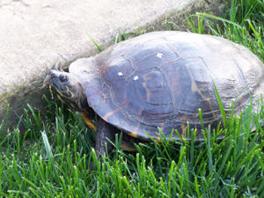
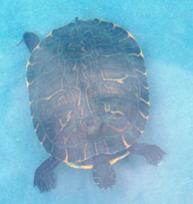
|
|
Re: Need help w/ turtle i.d.-what to
do?? 5/24/10
Bob - -
<Heather>
Thank you so much for the info. I did check out the link for the
care of an RES, however, is an indoor enclosure an option for
'Tommy'?
<Oh yes>
He seems A LOT bigger than the turtles in the pics. We will
definitely put some signs up near the bulk mailbox area to see if
anyone has lost their pet. If no one comes forward and we decide
that this is not something that we can do, should we take him
back to the pond area?
<I would not do this... there is too much chance of this
animal being a vector for disease to native wildlife... and being
an errant pet, unfamiliar w/ predators>
Is that painted turtle 'native' to Northern
California/Sacramento Area (where we live)?
<See the Net re...>
Also the whole pool thing, he just won't stay out. We do have
a kiddie pool that we pull out for our dog in the summer time;
should we put Tommy in that instead?
<... please read where you were referred... Turtles need
specialized care... this species, room to get out of the water,
provision of UV light wavelengths, heat... simple
foods/feeding...>
I really appreciate all your help. Thank you!
Heather
<Please help yourself. Read. BobF>
|
|
Which kind of slider turtle? ID
5/23/10
I found your website while doing a search for slider turtles and
have a question. My husband brought home a turtle today for our
kids, he found this guy under his truck at the water treatment
plant where he works. Once home we had no idea what kind of
turtle it was so I'm hoping you can help.
I have narrowed it down to the slider, but its not colored like a
red-eared or yellow bellied slider. He's got all the same
traits other than that one. He's about 7" long (not
counting the tail) with the long front claws and webbed back
feet, he's green and yellow striped all over and after being
submerged in the bathtub he's happy as a clam. I was
wondering if there were varying degrees of "red" on the
red eared sliders. He's got the solid patch where the ears
are, but its more a muddy brown that blends with the rest of his
head.
<If it looks very similar to a Red-ear Slider, Trachemys
scripta elegans, but lacks the red ear patches, then it is most
likely one of the other Trachemys scripta subspecies, such as
Trachemys scripta troostii or Trachemys scripta scripta. But it
could be one of the related species of Trachemys
("sliders") or Pseudemys ("Cooters"). Without
a photo it's difficult to be sure.>
As we live in NC where there's mostly box turtle and snapping
turtles, we wanted to find out as much as we could about him.
After reading all the upkeep I think we'll probably free him,
but I wanted to educate my kids on
this cool turtle before we let him go. There is a nice pond near
our home where we would probably let him go, is this right for
this turtle??
<Very difficult to say. If he's an escapee, then release
into the wild would be risky. Without recognizing predators, or
the danger of things like automobiles, he'd not last long.
Plus, if he isn't native to your area, releasing him into the
wild is not only dangerous for the local environment, but likely
against the law, too. It is MUCH better you contact
your local Fish & Wildlife agency or an animal rescue
charity, and have them deal with the problem in a the most
humane, ecologically sound manner.>
Thanks for the help!
Lori
<Cheers, Neale.>
Re: Which kind of slider turtle? -
5/23/10
Thanks for the names Neale. I Googled both of the kinds you
listed and still can't decide. He's very similar to the
Cumberland slider with the exception of the spots on the bottom.
This one has the 2 centered spots on the belly as with the
Trachemys scripta scripta. I'll have to upload some pictures
from my camera and send them to you. I'll also contact the
local wildlife officer, as we have a park nearby with people to
talk to!!
<Very good. The ideal outcome.>
In the meantime, will he be okay in our bathtub for another day
or so?
<Yes.>
I've been keeping the water above room
temp, changing it every few hours so he doesn't get cold.
<In summer this shouldn't be an issue.>
But I have nothing to put in there for him to climb above water
level.
<For a day or two, not a problem.>
I'm not sure what to feed him as far as plants but I did read
that they can go up to a week without eating. I would rather not
starve him though!
<Curly lettuce, raw white fish, cooked prawns are all suitable
items.>
Thanks again
Lori
<Happy to help. Cheers, Neale.>
Re Slider turtle - 5/24/10
Neale,
<Ahh, he's "out" today, tomorrow>
this is the slider we have in our tub. This is the best shot I
can get of his head, he's really shy unless totally
submerged.
Please let me know what you think. I am going to go to the park
tomorrow and talk to the wildlife officer and see how best to
release him, they might want to keep him! At least I'm hoping
so!!!
Thanks again for all the info!
Lori Merritt
<Looks like a healthy, though wild specimen. Good luck, life.
Bob Fenner>
|
|
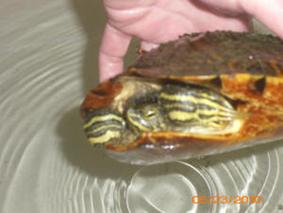
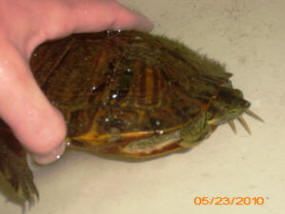
|
|
Turtle
Identification 7/14/2009
Can
you all identify this baby turtle for me?
<Yeah -- I think his name is Gary.>
<He might be a baby Box turtle (Terrapene) or any one of a
number of Emydid (water) turtles. The problem is that the
straight on top angle gives us just a vague outline. We can tell
he's not a mud, musk, soft-shell or snapping turtle. Not a
Tortoise or a sea turtle. He's not a Clydesdale Horse either,
but I suspect you already figured that out.>
<What I'd really like is a couple of face shots and one
from the side.
Not glamour shots of course, no hair or makeup needed .. just a
better angle to see his distinct features.>
<Unless you mean that OTHER thing .... that's not a turtle
at all, that's a quarter!>
<Regards - Darrel>
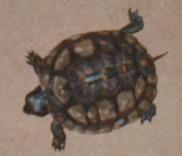
|
|
What kind of turtle is this?
4/30/09
My little girl found this turtle while fishing and wanted to keep
it. I would like to know what kind it is so I can give it the
proper care it needs.
<Hello James. The photos are too blurry to be able to tell
anything much, but it would appear to be a Slider of some sort,
Trachemys spp. So the basic requirements are not much different
to the popular Red-ear Slider, as outlined here:
http://www.wetwebmedia.com/FWSubWebIndex/RESCareBarton.htm
Now, before you give in to your daughter, think about how much it
costs to keep one of these. Most Sliders are big and messy,
eventually dinner plate-sized animals that need aquaria around 55
gallons in size, if not larger. Beside the tank, you'll need
a big external canister filter just to keep the water clean and
safe; without it, the water will become cloudy as well as toxic.
Minimum, you want a filter rated at 6 times the volume of the
tank in turnover per hour; for a 55 gallon system, that's 330
gallons per hour. So, the filter and the aquarium are already
setting you back the best part of $200. Next up is a heater (yes,
you'll need one, because the turtle won't be able to
hibernate in captivity when room temperature drops.
Without a heater, it will quickly become plagued with respiratory
tract infections that require care from your vet, not to mention
all the other problems reptiles succumb to when they're cold.
As if this wasn't enough, you'll also need a basking
lamp, specifically a UV-B lamp, without which the turtle will
rapidly become sick. It needs UV-B to perform certain chemical
reactions associated with bone and shell formation, among other
things. All told, you're going to be spending several hundred
dollars.
Because turtles grow rapidly, a smaller tank now (say, a 20
gallon system) would need to be upgraded within a couple of
years. Finally, there's diet: turtles can't be maintained
on "turtle food" from the pet shop, at least, not
entirely. You need to augment their diet on a regular basis
(i.e., every week) with fresh green foods. While not expensive,
quite the contrary in fact, this underlines the fact that Sliders
aren't "easy" pets. They're difficult to keep,
expensive, and around children at least, potentially hazardous
because Salmonella and other bacteria grow easily in their
habitats (especially if said habitat isn't kept clean!). They
aren't
especially pretty when they mature (most become fairly dull
green, and the yellow colour you see now will fade away) and
certainly have no interest at all in being handled. What I'm
trying to tell you is that you should stop and think EXTREMELY
carefully before taking on the burden of a pet turtle.
Much better to observe this animal in the wild -- where it
belongs, frankly -- and enjoy it for what it is, a wild animal.
Then maybe go with your daughter to a pet shop or book shop, buy
a book about keeping pet reptiles, and then decide if you, as a
family, are prepared to create a home for these admittedly
fascinating animals. Cheers, Neale.>
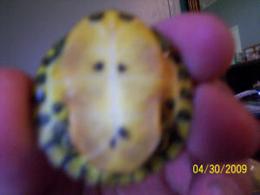
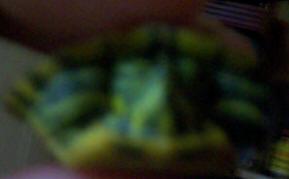
|
|
2 part question about turtles and
identification 8/26/08
Dear
Crew,
<Hiya -- Darrel here>
Ok, so this is a two part question, first what kind of turtle is
this??
<Oh dear .. if I'd known there was going to be a test
I'd have studied!!>
<When I first looked at the pictures my sense was that it was
a Rhinoclemys (a South American Wood Turtle). When young their
carapace (top shell) is fairly flat and somewhat resembling an
Pseudemys (the slider families) and as they mature it becomes
more domed like a Box Turtle (Terrapene). In this case, Google is
your friend. Try Rhinoclemys T Terrapene and reeves turtle
and see what you think>
I got him from a lady who was not taking care of her and she gave
her to me. After cleaning her up I put her in my 100gal tank with
my RES who is a male (very long claws) who I have had for about a
year, and is just a little smaller then the new turtle.
<Not sure the new kid on the block is an aquatic turtle though
-- from most aspects it appears to be semi-aquatic at best and
needs more dry land. Your identification from more comparison
photos will tell all.>
The other day I noticed my RES vibrating his legs in her face, so
he wants to mate with her, so if you know what kind of turtle
this is, are they close enough for them to mate or is he barking
up the wrong tree?
<Yes, in this case my guess is that you're shaving the
wrong beard, to make a different metaphor>
thanks for your help!
<I'm also passing your pictures along to a more learned
colleague for his opinion. Neale?>
|
|
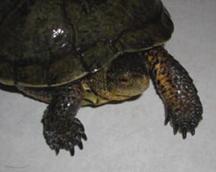
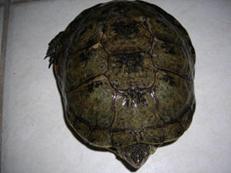
|
|
2 part question... Turtle ID,
cross-breeding? -08/27/08
Ok, so this is a two part question, first what kind of turtle is
this??
<I have absolutely no idea. The fact the shell is domed rather
than flat implies its either an amphibious or fully terrestrial
species rather than a truly aquatic species. The front feet
appear to lack webbing, but the back feed are webbed, so again,
I'd tend to go with some type of amphibious rather than truly
aquatic species. I would be keeping this species in an enclosure
with equal amounts of water and land, and I'd also make sure
the water wasn't too deep. But I really think you need to get
in touch with a dedicated Chelonian support/rehoming site such as
Turtle Homes:
http://www.turtlehomes.org/
They have contacts and resources for identifying
"mystery" Chelonians.>
I got him from a lady who was not taking care of her and she gave
her to me. After cleaning her up I put her in my 100gal tank with
my RES who is a male (very long claws) who I have had for about a
year, and is just a little smaller then the new turtle. the other
day I noticed my RES vibrating his legs in her face, so he wants
to mate with her, so if you know what kind of turtle this is, are
they close enough for them to mate or is he barking up the wrong
tree? thanks for your help!
<They are absolutely not the same species! Male Red-ear
Sliders will attempt to mate with anything. So long as he
isn't harassing her, I wouldn't worry too much. Cheers,
Neale.>
|
|
What Kind of Turtle Is This?
5/3/08
I found this terrapin (or turtle) in my
garage. He was literally hitting the door. When I first looked out
I didn't see anyone but the next time I went out the front door
and into the garage and this is what I found. Please identify. What
does he eat. I plan to let him go. He's got inch long finger
nails and the back feet are kinda webbed. Mary in Arkansas
<Hello Mary. It's difficult to ID this beast without
seeing the head more clearly, but I'm fairly sure that it is
either the Yellow Bellied Slider (Trachemys scripta scripta) or
the Red Eared Slider (Trachemys scripta elegans). As their names
suggest, the difference between them is that one has red flashes
on the sides of the head, and the other doesn't. Basic care
is identical. Nice pets, but if you're not up to homing the
terrapin in question, then get in touch with your local Fish
& Wildlife department or Humane Society for information. Red
eared Sliders are at least native to your state, in which case
the Fish & Wildlife department may be able to tell you where
to safely release the animal back into the wild (if that's
the species in question). The Arkansas Herpetological Society may
also be able to help.
http://www.snakesofarkansas.com/Main/Turtle
Cheers, Neale.>
Re: What Kind of Turtle Is This? 5/3/08
Thanks Neale, I just wanted to be sure this wasn't an
endangered species. I live out in the country and will probably
just let it go in my woods. There is a creek about 200 yards
away. Maybe I can get a better picture of the head. I'm
anxious to let him go. It's probably ready to catch some
bugs, or whatever it eats. Mary in AR
<Hi Mary. Please confirm with your Fish & Wildlife
department before releasing the animal. While it may be a wild
animal, it could equally easily be an escaped pet from a nearby
home. Pet animals can carry diseases that seriously harm
wildlife, and they can also cause problems by disrupting natural
ecosystems. Pet animals may be less adept at finding food and
escaping from predators, so that's another issue. Putting the
turtle in a box with a shallow bowl of water for drinking is
really all it needs for a few days. Starvation isn't an
issue, so don't worry about that. (It eats mostly plants, as
it happens, rather than bugs.) While I'm fairly sure your
beastie is merely a wild animal that took a wrong turn on its
travels, you can't be too careful, so check before letting it
go. Cheers, Neale.>
Re: What Kind of Turtle Is This?
5/3/08
Thanks Neale, I have sent pictures to the
address you sent -
http://www.snakesofarkansas.com/Main/Turtle
Waiting for a reply. Mary in AR
<Cool. Good luck, Neale.>
|
|
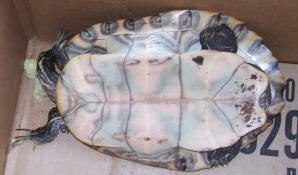

|
Baby turtle identification & care
07/24/07
Hello,
<Hi there -- Darrel here>
Well my aunt got me a turtle while going fishing.
<I'll take that to mean she brought BACK a turtle from her
fishing trip>
It's very small. I think it's a baby or that's just how
there species look, but to the point it just started eating its food
today and it's been having this clear floating stuff on it, and it
wont come off.
<Sounds like it might be a fungus, but 'clear floating
stuff' is a little vague. Is it soft, like dead skin or hard, like
a film on the shell? Please write back with a more detailed
description>
And what type of items am I suppose to put in there with it? I just
don't know what to do.
<Try this link to get an idea of basic care:
http://www.wetwebmedia.com/FWSubWebIndex/RESCareBarton.htm
and try this link to see if you can identify what it looks like:
http://www.xupstart.com/wwm/
Hope this helps>
Turtle ID Needed 9/6/06
Hi. I live in PA and
recently found a turtle which I am planning to release, but I would
like to know what kind it is first to find the proper location site. I
have searched and have had no luck! The turtle has a black or dark
green shell with no spots. It has a orangish belly with yellow stripes
on the neck and red spotted/stripped legs! See what I mean she is
complicated. Could you please help me? I want to do what is best for
her.
P.S she has a flat belly so I assumed she was a female!
your help would be much appreciated thank you.
< Do a google search on Eastern or Midland Painted Turtle. Both are
found in your area. Once you find a picture then you can determine
which one you have.-Chuck>
Sexing An Unknown Turtle Species
8/19/06
HI. I have 2 gammarus turtles and I want to know if
they are boy or girl can you help me? ana
< Don't know what a gammarus turtle is? Gammarus is a shrimp
often used as food for turtles and fish. A good photo might help with
the ID.-Chuck>
Red Eared Slider? 2/24/04
<Hi,
Pufferpunk here>
I have a turtle and I don't know what kind it is.
<1st of all, I must insist you write in sentences & use capital
letters when necessary. All the questions sent to us are
posted on our website & I have to take a lot of time to correct
this, before I can send it on to the site. This takes time
away from answering other questions.>
I need to find out because I have a project that I have to do.
<What kind of project?>
It is about the size of a half dollar and it has kind of diamond shapes
in the middle of its shell. It has like brownish red by its ears. It is
green and yellow do you know what kind it is?
<It sounds like a red-eared slider. Is this your turtle?
http://www.tpwd.state.tx.us/nature/wild/reptiles/slider.htm>
I could really use some help!
<I'm surprised you were able to purchase this turtle at that
size. It is illegal to purchase aquatic turtles under
5", due to their carrying salmonella bacteria. Good
luck with your project. I hope it is not harmful to the
turtle in any way. These turtles need clean filtered
water. They need a lot of swimming room, & a piece of
land to bask on, with a heat lamp above. Small strips of
fish, krill, shrimp, crickets & worms are what they like to
eat. They also need a source of minerals for their shell, by
vitamins & a sulfa rock in the
water. ~PP>
Source to identify unknown
turtles
(Original heading: Turtle Tank
Goodies)
Hi umm,
<Gage here, but you can call me umm if you want to.>
This is my first time ever owning a turtle. I got it from a friend,
I'm not sure on the sex, or even what kind it is exactly.
<I'd be willing to bet it is a red eared slider, but cannot say
without a picture. Tons of info on turtles online -
http://www.tortoisetrust.org is a good one>
I've had this turtle for about 9 months, almost 10 now. I was
cleaning out the filter and the tank today, and there were all these
very tiny little seashells all over the place, and I have no idea where
they're coming from. Do you have any idea where they could be
forming from? They're sort of coned shape, and looks like
there's something in them, but they're so small it's hard
to tell. Well I hope you can help me...thanks -megs
<Most likely they are snails. Snail eggs have sneaky way
of getting into your tank, nothing to worry about.
-Gage
To: Part 2,
Part 1
|
|

